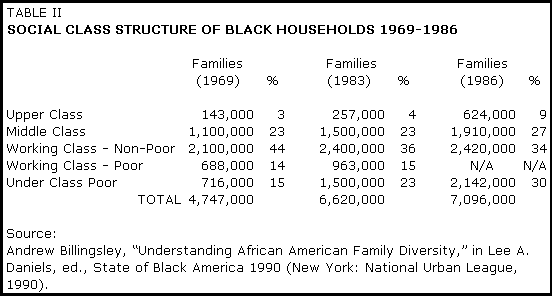What the foregoing discussion of the new social class capabilities available to the middle-class and professional sector of African-Americans reveals is that today’s Black America is defined by a two-tier class system. This two-tier class system comprises two main class categories. The lower-tier can be called a “static-stratum", made up of weak working-class and poverty-level African-Americans. Persons in the “static-stratum” hold a variety of weak working-class jobs in factories (janitors, cleaning machinery, unskilled laboring tasks, etc.). They also hold a variety of unskilled jobs in the service economy — e.g., jobs in food-service business, jobs in cleaning service in hospitals, cleaning in public institutions, and domestic service jobs.
I categorize the upper-tier in Black America’s two-tier class system as a “mobile-stratum”, made up of middle-class, professional class, and capitalist class African-American persons and households. The Black middle-class sector includes stable blue-collar workers, teachers, clergy, barbers, hairdressers, artisans, storekeepers, sales clerks, etc. The professional ranks in the “mobile-stratum” include lawyers, doctors, dentists, nurses, health administrators, college professors, engineers, scientists, technologists, accountants, state/federal administrators, public officeholders, artists, journalists, media professionals, etc.
The ranks of African-Americans in capitalist occupations include a broad range of business persons whose occupations are regularly listed in monthly issues of the major African-American business journal Black Enterprise Magazine. These occupations include the following: construction contractors, automobile dealerships, manufacturers, hotel owners, restaurant franchisers, advertising firms, architectural firms, financial managers, bankers, etc. A selected list of capitalist occupations held by African-Americans is shown in TABLE I.
Today the upper-tier or “mobile-stratum” constitutes, in aggregate, about 60% of African-American households. On the other hand, the lower-tier or “static-stratum” constitutes, in aggregate, about 40% of African-American households. This “mobile-stratum”/”static-stratum” classification of today’s early 21st century African-American class system corresponds to an analysis by Morgan State University sociologist Andrew Billingsley which was done for the National Urban League’s 1990 annual volume titled State of Black America 1990. TABLE II presents Professor Billingsley’s data. His top-three class categories — upper class (9%), middle class (27%), working-class non-poor (34%) — approximate what I call today’s “mobile-stratum” among African-American households. His bottom-two categories – a combination of working-class poor and underclass (28%) — approximate what I call today’s “static-stratum” among African-American households. Accordingly, following Professor Billingsley’s class categories used in his 1990 National Urban League study, in overall terms I classify 40% of African-American households as belonging to the “static-stratum” and 60% belonging to the “mobile-stratum”.
We can gain a sharper view of the “static-stratum” by looking at data from a U.S. Census Bureau survey of American occupations in 2002. That survey reported that low-paying jobs at the bottom of the American occupation ladder (with the exception of “farming, forestry, fishing”) accounted for 4,163,000 Black workers or 28.2% of all employed African-Americans. Returning to Professor Billingsley’s study for the National Urban League’s State of Black America 1990, he provides data on a major crisis-area facing Black Americans in the “static-stratum” — namely, fragile families. Billingsley records that “working-class poor” Black households had a 67% single-parent rate, and that “underclass” Black households had a 75% single-parent rate. This fragile family pattern means, moreover, that over 60% of African-American children are being raised in economically distressed family dynamics. An overall view of these economically distressed family dynamics is provided by national-level poverty data, which show that as of 2005 the poverty rate for African-Americans was 25% (down from 32% in the 1980s), as compared to a 29% poverty rate for Latino-Americans.

The emergence of a two-tier class system in African-American society during the post-Civil Rights Movement era has resulted in what I’ve already referred to earlier as a “troubled Black America.” This is a Black America many of whose citizens now witness their life-chances being strangled by an array of social crises. While the American national economy and the federal government have the major moral responsibility for assisting in remedying African-Americans’ social crises, there is an important contribution to remedying these social crises that today’s Black elite sector can also make. I want to conclude this article with a discussion of what that contribution might be.



